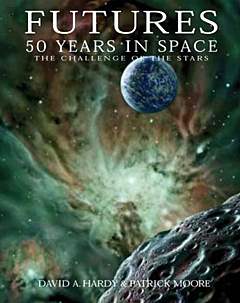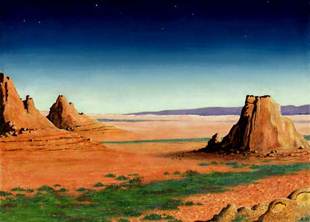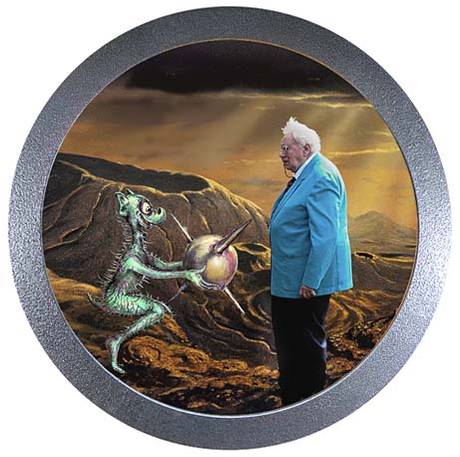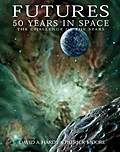 |

Futures: 50 Years in Space
The Challenge of the Stars
extracts from the book
by David A Hardy and Patrick
Moore
"Dedicated to the crew of the Space Shuttle
Columbia, who died during re-entry on 1 February, 2003. They
accepted the challenge and the risks, but their wish was for their
dreams, and ours, to become reality."

David Hardy's space art
is unique. He creates his own special kind of virtual reality; through
his astounding vision and technique we glimpse landscapes in worlds
where man has never set foot. One of my most treasured possessions
is a painting by David Hardy of a total eclipse in Chile which we
attended together. It captures the awesome beauty of the occasion
far better than any photograph I have seen. So it is in these pages,
where, through David's visionary art, we clearly 'see' the beginnings
of the fulfilment of man's dreams of space.
Futures is a fitting testament to
David's long-standing collaboration with Sir Patrick Moore, who, through
his record-breaking "The Sky at Night" BBC series, has inspired generations
of astronomers. In the pages of this wonderful book these two men
take us out to the stars...and beyond.
...Dr Brian May, Queen
guitarist and astronomer

Pages 6-7
OVERVIEW; 1954-2004
The twentieth century was the Age of  Challenge.
In 1903 came the first manned flight in a heavier-than-air machine;
in 1926 came the first liquid-fuelled rocket; there followed the first
flights above the main atmosphere of the Earth, and then, in 1961, the
pioneer flight of the first spaceman, Yuri Gagarin. By 2000, men had
reached the Moon and unmanned spacecraft had surveyed all the planets
apart from remote Pluto. All this was a prelude to what may well be
the Age of Achievement -- the twenty-first century. Challenge.
In 1903 came the first manned flight in a heavier-than-air machine;
in 1926 came the first liquid-fuelled rocket; there followed the first
flights above the main atmosphere of the Earth, and then, in 1961, the
pioneer flight of the first spaceman, Yuri Gagarin. By 2000, men had
reached the Moon and unmanned spacecraft had surveyed all the planets
apart from remote Pluto. All this was a prelude to what may well be
the Age of Achievement -- the twenty-first century.
When we -- Patrick Moore and David A. Hardy -- first discussed the
idea of a book to be called The Challenge of the Stars, as long
ago as 1954, we hoped that we could make forecasts with reasonable accuracy.
First, an orbiting space-station and then an expedition to the Moon,
establishing a base, small at first but growing steadily. Building upon
the lunar experience, humankind would send an expedition to Mars, perhaps
setting up a base there too. Jupiter's satellites and the outer Solar
System would be the next targets and perhaps, eventually, the stars.
Our schedule seemed logical enough, and the Moon was indeed reached
in 1969, before most people had expected. But thereafter things did
not go entirely according to our plan. By the time the first edition
of The Challenge of the Stars was published, in 1972, humanity
was about to go to the Moon for the last time it would do so
in the 20th century, in Apollo 17. For motives that were political rather
than scientific, the USA had chosen to visit the Moon first in a single,
expendable vehicle. True, a year later NASA did put Skylab into orbit,
and this was in effect a space-station, but it was not intended to be
permanent, and it was not developed. Russia (then the USSR) followed
with Salyut and Mir, and by the end of the century the International
Space Station (ISS) was under construction, but even now there are no
firm plans or commitments to send people back to the moon or set out
for Mars.

There seems to be a 'window of opportunity' within which humans can
choose whether or not to become a spacefaring race while we still have
the knowledge, the means and the resources to do so. Sadly, this window
seems to be closing at an increasing rate. We hope that in some small
way our book will act as an optimistic reminder of what lies out in
space, waiting for our exploration -- and even exploitation, as in minerals
from the Moon and asteroids, together with the advantages of solar power.
Moreover, if we have the foresight and will to make it happen, it will
amaze, excite, and enrich the lives of the next generations: your children
and your children's children.
Remember the words of that great visionary, Arthur C. Clarke, written
in 1968, when the outlook seemed so promising:
The challenge of the great spaces between the worlds is a stupendous
one, but if we fail to meet it, the story of our race will be drawing
to a close. Humanity will have turned its back upon the still untrodden
heights and will be descending again the long slope that stretches,
across a thousand million years of time, down to the shores of the
primaeval sea.
Having said that, the fifty years between our first
visions and today's reality have seen the most amazing discoveries and
advances in astronomy as well as in space technology. In 1954 photography
had yet to be superseded by electronic devices, and some of the ideas
then current seem very old-fashioned today.  The
brilliant, canal-building Martians of Percival Lowell had been consigned
to the realm of myth, but Mars was still believed to have vast tracts
of vegetation. Venus might have jungles, or oceans of soda-water; Saturn
was the only ringed planet, and we knew nothing about the volcanoes
of Io, the lava-flows on Venus, geysers on Triton or the amazing diversity
of the moons of the outer planets. Neutron stars, quasars, pulsars and
black holes were not only unknown, but mainly unsuspected, while estimates
of the age of the universe as we know it were little more than guesswork. The
brilliant, canal-building Martians of Percival Lowell had been consigned
to the realm of myth, but Mars was still believed to have vast tracts
of vegetation. Venus might have jungles, or oceans of soda-water; Saturn
was the only ringed planet, and we knew nothing about the volcanoes
of Io, the lava-flows on Venus, geysers on Triton or the amazing diversity
of the moons of the outer planets. Neutron stars, quasars, pulsars and
black holes were not only unknown, but mainly unsuspected, while estimates
of the age of the universe as we know it were little more than guesswork.
Thanks to the probes such as the Mariners, the Veneras,
the Vikings and the Voyagers, we have learned a great deal since then,
and the developments in instrumentation have been truly staggering.
In 1954 the world's largest telescope, the 200-inch Hale reflector at
Palomar in California, was in a class of its own. Today it is regarded
as being of no more than medium size, and we have of course the Hubble
Space Telescope (HST), soaring high above the main part of the Earth's
atmosphere.
The second edition of The Challenge of the Stars,
published in 1978, did include many changes; the sky of Mars had become
orange-pink rather than dark blue, and Titan, Saturn's main satellite,
was very different from what we then envisaged. But when we came to
prepare this new version, Futures, we realized that the developments
between 1954 and 1978 were in no way to be compared with those between
1978 and 2004. It seems that almost every week brings its quota of new
discoveries -- and space art, as well as space science, has moved with
the times.
Just as the images from space are now gathered or processed
electronically or digitally, many of the new illustrations for this
book were produced on an AppleMac. (This does not mean, though, that
they are 'computer-generated', Although this method of working has undoubtedly
speeded up the process of illustration, pushing paint around on art
board or canvas has mainly been replaced by pushing pixels around on
a monitor!)


Pages 20-21
MARS IN THE 1970s
The problem for telescopes of the 1950s was that Mars never
comes much within 35 million miles of us, and they could never show
it more clearly than a view of the Moon with good binoculars. The first
successful Mars probe, Mariner 4, did not fly past the planet until
1965. One feature it recorded is visible with Earth-based telescopes
as a tiny speck, and was named Nix Olympica, the 'Olympic Snow'; it
was assumed to be a large crater. Only when Mars could be seen from
much closer range was it found that the feature is in fact a giant volcano,
three times the height of Everest. It is now known as Olympus Mons --
Mount Olympus -- and is believed to be the highest and most massive
volcano anywhere in the Solar System. Whether it is extinct, dormant
or even mildly active is a matter for debate.
All our ideas about Mars had to be drastically revised in 1971, the
year we had our first views of the huge volcanoes and the systems of
canyons. Then came the two Vikings, which were launched in August 1975
and reached Mars in mid-1976. One of their main tasks was to search
for life, and this involved making controlled landings; the Lander was
separated from the Orbiter and brought down to the surface, slowed down
partly by rocket braking and partly by parachute. Tenuous though it
is, with a ground pressure below 10 millibars everywhere, the Martian
atmosphere is substantial enough to make parachutes useful.
Both landings were successful. Viking 1 came down in the 'Golden Plain'
of Chryse, 20 degrees north of the equator (10th June) and Viking 2
landed in the more northerly plain of Utopia (7th August). Excellent
images were sent back, relayed by the Orbiter. Rocks were everywhere;
the sky was yellowish-pink, rather than dark blue as had been expected,
and windspeeds were gentle. Temperatures were of course very low --
far below freezing point. One NASA investigator, Garry Hunt, produced
a wry weather forecast for Mars: "Fine and sunny; very cold; winds light
and variable; further outlook similar." Not surprisingly, he proved
to be completely accurate! Dust storms do occur, and can be global,
but in general the atmosphere is very clear.

Each Lander was equipped with a 'grab' -- basically a scoop with a
movable lid, which could collect surface material and draw it back into
the main spacecraft, where it could be analyzed in what was to all intents
and purposes a tiny but highly efficient laboratory. There were three
experiments, all designed to detect biological activity. The results
were decidedly puzzling, but in the end they were generally regarded
as negative, and there was no firm evidence of life of any kind.
Throughout the twentieth century all the useful results from Mars missions
have come from American spacecraft. The Soviet Union launched its first
Mars probe as early as 1961, and others followed. But even today the
Russians have had no success; all their Mars spacecraft have failed
for one reason or another. This is all the more surprising in view of
their excellent results from Venus, which logically would be expected
to pose far more difficult problems.
Obviously, manned flight to Mars must be many orders of magnitude more
hazardous than a trip to the Moon. The astronauts must endure months
of weightlessness and there is, perhaps above all, the danger from radiation;
to provide adequate protection on a spacecraft is very difficult indeed.
Neither are we yet sure whether the thin Martian atmosphere will be
of any real use as a radiation screen.
Yet the Viking results were encouraging enough for NASA to press ahead
with a design for the first Martian base. It would be primitive, but
it would be essential, because the astronauts would have to spend some
months on Mars before it and Earth were suitably placed for the return
journey. Walking about in the open with no protection apart from warm
clothing and an oxygen-cylinder, as envisaged only a few decades earlier,
was known to be out of the question because of the unexpectedly low
atmospheric pressure. Blood would boil inside the body, causing a quick
but unpleasant death. Full pressure-suits must be worn all the time,
and, naturally, any base must be very effectively airtight and pressurized.
In the 1970s it was still thought that the polar caps were very thin,
possibly no more than a surface layer of solid carbon dioxide; only
much later was it found that the caps are thick, and made up of water
ice. We are also sure that even away from the poles there is a great
deal of underground ice, so that future colonists will never be short
of water. In this respect Mars is much more co-operative than the Moon.
In 1972 it was thought that the first manned expeditions might set
off before the end of the century. This has not happened, but it will
indeed be strange if attempts are not made during the next few tens
of years, and will lead on eventually to permanent bases. It is very
likely that 'the first man on Mars' has already been born!


Text and images © David A Hardy and Patrick Moore 2004.

Futures: 50 Years in Space is published by AAPPL (Artists' and
Photographers' Press Ltd, May 2004, ISBN: 1904332137).
Order online using these
links and infinity plus will benefit:
...Futures: 50 Years in Space, from Amazon.com
or Amazon.co.uk.

Elsewhere in infinity plus:
- fiction - Aurora,
an extract from David A Hardy's novel.
Elsewhere on the web:
|
 |









